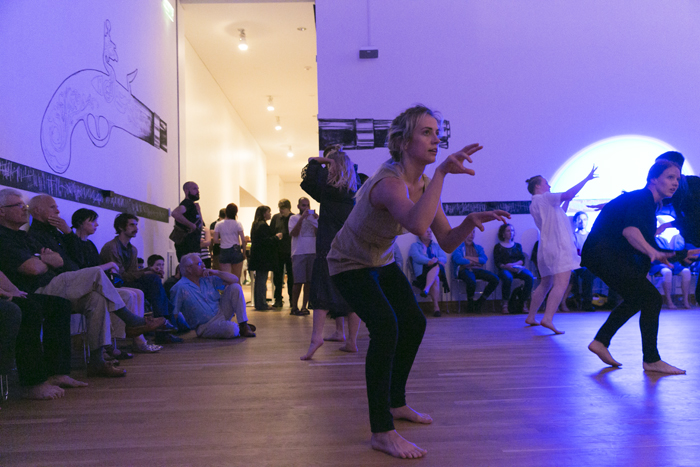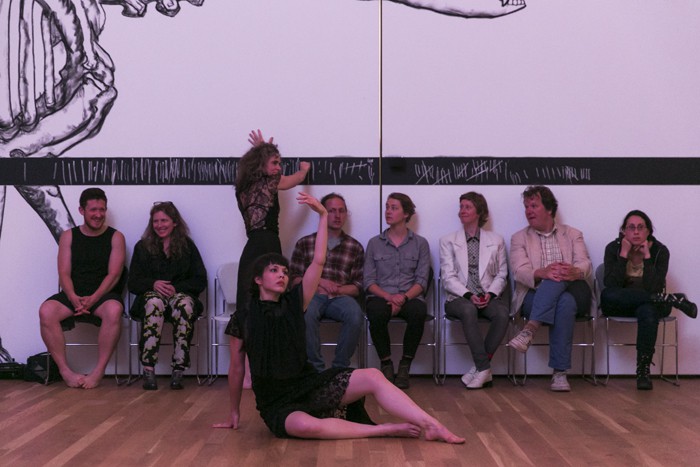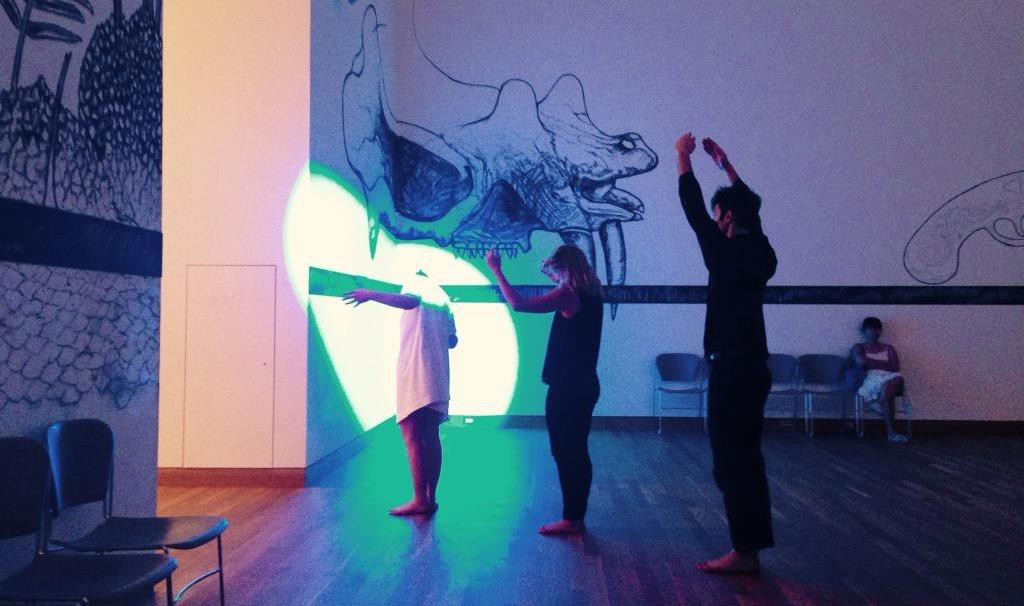“Still Life” Moving
Camille LeFevre reviews Morgan Thorson's new "endurance-based dance work," happening in the Weisman Art Museum galleries all summer long.

As usual, the title of choreographer Morgan Thorson’s current work, Still Life, is as layered with meaning (served up in feints and asides) as her eminently watchable and surprising choreography. For one thing, a still life—as in painting—is an artwork that often figuratively, sometimes hyperrealistically, portrays an array of inanimate objects: fruit, vegetables, deceased animals and fowl; knives and platters and drinking vessels, for instance. In viewing such works, one gets a sense of time compressed. We understand the action and intention that’s gone into preparing these objects for contemplation. We also sense how, although objects are preserved in a perennial present through the artist’s rendering, decay is a breath away. Time never stops passing, despite our aesthetic efforts.
Conversely, Thorson’s Still Life is a cornucopia of gesture, expression, kineticism, vocal outbursts, and long skeins of sinuous, frenetic, intertwining, elastic and precise movements. The five-hour piece, which takes place in a gallery of the Weisman Art Museum throughout the summer, also includes moments of stasis. From time to time, one of the performers disappears for a while—presumably to rest and rehydrate. Referred to in the press materials as an “endurance-based dance work,” the piece is intended to test both the dancers’ and viewers’ stamina.

That concept, of course, isn’t new. Performance artists from Joseph Beuys (I Like America and America Likes Me, 1974) and Marina Abramović (The Artist Is Present, 2010) have famously and publicly portrayed their endurance with works occurring in museums that test the boundaries of time and space; intimacy, movement and immobility. Nor is dance in museums new. Moreover, it’s becoming something of a trend. What Thorson’s Still Life offers, however, is a portrait of the dancer as a repository of kinetic memory, a portal through which time and space are given form, and physical media for expressing emotion, innovation, energy and delight.
Still Life is just one of the works on view this summer as part of the Weisman’s Local Time, an exhibition “whose work addresses time as both subject and practice.” As a “time-based practice,” Thorson’s choreography cycles through every two hours, beginning and ending again, then ending at the five-hour mark. On the Sunday afternoon I watched Still Life, Thorson was present and taping the performance. Clearly, the work is a finely tuned piece of choreography performed with diligence, intelligence and nuance. But it’s also clear—given the choreographer’s frequent murmurs of pleasure and approval—that moments, even whole sections, are improvised, imbued with inflections Thorson didn’t expect.
Nineteen performers take turns with the work. Five of them performed on the day I attended, only one of whom I recognized. That dancer, Anna Marie Shogren, was cautious and alert. A spritely dancer wearing something like a 19th-century baptismal dress darted here and there with levity. Another performer, a brunette, was quiet and furtive in her gestures, while a woman with platinum hair was sleek, with quicksilver, fleeting movements. The lone man in the group seemed reverential.

Their gestures ranged from a low, athletic bicep curl and the uncovering and display of a shoulder to a slumped walk with chin on hand, dangling T-rex hands, and reaching under and over an armpit. The performers flung, grabbed and tossed themselves around the space. They also expressed joy, ennui, longing and yelled defiantly while aggressively scissor-kicking. A crouch unfolded and lengthened into a stance of awe and contemplation. There was a period of intertwining limbs, and a dance circle during which each dancer took a turn. Flashes of a children’s game (Duck Duck Goose) intermingled with dreamy, sinuous phrases and rigid motion that found its terminus at the wall.
Chairs were used for sitting, turning, dividing the space with objects. A blackboard border along the walls holds containers with chalk, with which dancers drew counting lines. Also on the walls are drawings of a giant dinosaur skeleton and a gun (designed by Joel Sass). Lenore Doxsee’s lighting design includes an illuminated circle that moves across the walls and, by turns, resembles the sun, the moon, an egg, an opening, or a window. Dana Wachs’ score, which cycles along with the choreography, is atmospheric and melodic with ambient sounds. Sarah Baumert’s costumes are simple ensembles in black, gray and white.

In 2004, San Francisco choreographer Joanna Haigood created the site-specific work Ghost Architecture, whose set recreated the outlines of the structures that formerly occupied what is now a gallery at the Yerba Buena Center for the Arts. That piece, too, was cyclical, with the performers moving through a repeating series of vignettes during an afternoon that compressed time, space, and history into a moving portrait of a community long lost. Still Life doesn’t claim any such site specificity, nor should it. And yet, in its duration and its concentration on time as both motivation and subject, Still Life calls to mind Haigood’s piece.
What both works accomplish, for the viewer, is a forced sort of slowing down; a commitment to staying, to witnessing time’s passage as history is made, as bodies fatigue and the afternoon decays. Moreover, as a tableau, Still Life is anything but still, but it is full of life. A fresh inventive piece, even as it displays the toll it takes on the performers, Thorson’s latest is a work of tenacity and resilience—an apt metaphor for dance, right here, right now.
Related event information:
Local Time, the exhibition of which Morgan Thorson’s Still Life is a part, is on view at the Weisman Art Museum in Minneapolis from June 13 to September 13, 2015. Featured performers include: Emily Gastineau, Hope Grathwol, Margret Johnson, Sam Johnson, Amy Jones, Eben Kowler, Alexis Lautenbach, Pareena Lim, Tom Lloyd, Dustin Maxwell, Kara Motta, Genevieve Muench, Valerie Oliveiro, Anat Shinar, Anna Marie Shogren, Kristin Van Loon, Arwen Wilder, Max Wirsing, and Maggie Zepp. This project was researched with Alexis Heruth, Judith Howard, and Simone Richard.
Performances of Still Life take place in the galleries throughout the exhibition’s run, Wednesdays from 3 pm to 8 pm; Thursdays, Fridays, and Sundays from noon to 5 pm. Attendance is free and open to the public.
Camille LeFevre is a long-time dance writer in the Twin Cities and the editor of The Line, an online publication about the creative economy of the Twin Cities.